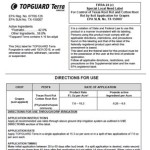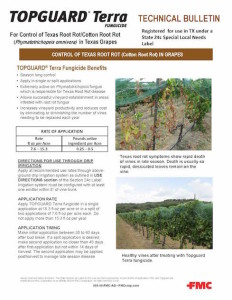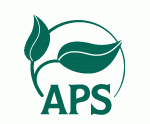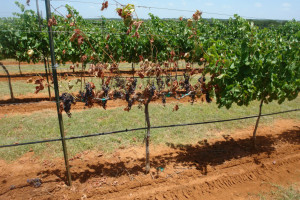
Symptoms of diseased grapes caused by Phymatotrichopsis omnivora.
Dr. David Appel, Extension Plant Pathologist with the Texas A&M AgriLife Extension Service contributed this article that describes a new treatment for one of the most devastating diseases of Texas winegrapes. This was research conducted by Dr. Appel and our own TPDDL diagnostician, Sheila McBride. -KO
This disease, cotton root rot, occurs on winegrapes in the calcareous soils of Central, South, and West Texas where soil pH is well above 7. The most common symptom of CRR in grapes is a sudden wilt and death of the infected vine. All of the leaves on the vine usually turn yellow and quickly become brown and dry. Vines often die in groups as the fungus advances underground along trellises to adjacent vines. Taproot, crown, and lower stem tissues appear dark brown and decayed after the dead bark is removed with a pocket knife. The symptoms become most obvious during the mid-to-late summer months, or when soil temperatures exceed 82o.
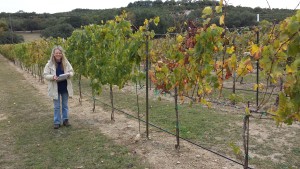
McBride evaluating experimental grape plots in 2014
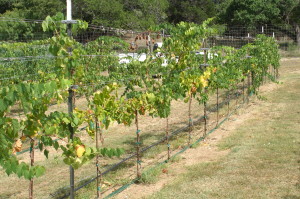
More Cotton root rot damage on grapes.
As a result of four years of research on control of CRR in winegrapes, a fungicide has been found to reduce losses caused by this deadly disease. Cotton root rot, aka Texas root rot, is caused by the fungus Phymatotrichopsis omnivora, the same fungus that kills cotton, peaches, apples, and other specialty crops and ornamentals in Texas. This fungus survives for years in infested soils. The fungicide is called TOPGUARD® Terra and is now available for winegrape growers to use in their vineyards. TOPGUARD® Terra was labeled for use on cotton root rot in cotton two years ago, prompting us to test the same treatment on the disease as it occurs in vineyards. Research plots were established at three locations in Central Texas where there was perceived to be a high risk of infection by the fungus. The root zones of vines were soaked with different rates of the fungicide and then the vines were observed for disease development. By comparing the disease in treated vines with untreated control vines, it was apparent that the fungicide was effective in preventing losses. The effective rates and application methods were developed from the studies and are available in the materials referenced below.
The Texas Department of Agriculture requested a Section 24c registration for use of the fungicide on winegrapes based on current research results, called a “special local need registration”. A 24c registration is reserved for pest situations in a state for which there are no existing pesticide products. This applies to the case of TOPGUARD® Terra on cotton , where there is a federally registered pesticide already shown to be effective on additional pests. However, winegrapes are not yet on the same label as cotton. In order to use the fungicide on winegrapes, a special copy of the TOPGUARD® Terra label must be in hand in order to apply it in vineyards. A copy of the label for downloading can be found below. Remember – you MUST have this additional label on hand when applying TOPGUARD® Terra on winegrapes in order to comply with pesticide regulations. Also, a bulletin prepared by FMC Corporation can be found. This bulletin contains some background information on how to use the product as well as some expectations for control when properly applied. The fungicide may be purchased from most local agricultural retail outlets.
24c Topguard Terra SLN TX label
Topguard Terra Grapes Technical Bulletin Final
This research was funded in part by support from the Texas Department of Agriculture Specialty Crop Block Grants (TDA SCFB-1112-001, SCFB-1213-036 and SCFB-1415-022) and the Hill Country Grape Growers Association. For more information about this research, Dr. Appel can be reached at appel@tamu.edu .

